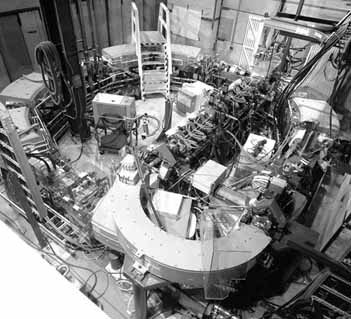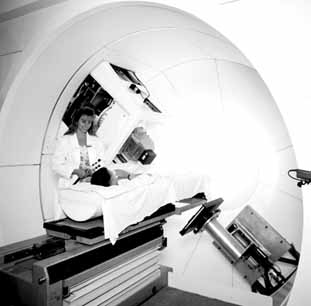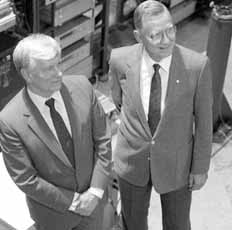 |
|
Protons Against Cancer by Kurt Riesselmann
Fermilab's role in cancer treatment is a case in point. Last month the Loma Linda Proton Treatment Center celebrated 10 years of treating cancer patients using particle beams from a compact proton accelerator completely designed and built at Fermilab. In the decade of the Center's operation, accelerator technology from Fermilab has provided cancer therapy at Loma Linda for more than 6000 patients from around the world. Cancer is the second leading cause of death in the United States, exceeded only by heart disease. Nearly five million lives have been lost to cancer since 1990, and physicians have diagnosed almost three times as many people with cancer during the same period of time. With people living longer than ever before, their chance of developing cancer is at an all-time high. The good news is that improved techniques for early diagnosis and more effective treatment methods save millions of lives. As alternatives to chemotherapy, hormone treatment and surgery, physicians have worked with physicists to develop therapies based on the properties of subatomic particles. The use of radioactive seed implants and beams of photons (x-rays), electrons, protons or neutrons have become standard treatments, refined through decades of research and clinical trials. Today, therapy with particle beams is a well-established medical field, and progress in beam physics and accelerator technology have helped to reduce side effects. Physicians have a much better understanding of what forms and amounts of particles are the best for different types of cancer. "Improved control of cancer and reduced treatment side effects have now been documented," said James Slater, M.D. and director of the Proton Treatment Center. He welcomed more than 600 patients who had returned to Loma Linda on November 12 for the 10th anniversary celebration. "[Our] proton radiation treatment system has been highly successful, although it is still in its infancy in terms of its ultimate potential." In particle beam therapy, physicians treat cancer by directing beams of particles at cancerous cells. Patients are carefully positioned, and a beam is applied to cancerous body tissue for one to three minutes. The beams damage the DNA strands of cells, destroying the cells' ability to divide and grow. Depending on the type of beam, it either destroys atomic nuclei inside the cells (high energy transfer by neutron beams; patients typically receive 10 to 15 applications) or the beam particles knock electrons off molecules, causing chemical reactions that damage the DNA (low energy transfer by photon, electron or proton beams; typically 30 to 40 applications). Depending on the size and type of a cancerous tumor, physicians develop an individualized treatment plan for each patient, to minimize damage to healthy cells. Particle accelerator laboratories have been home to clinical studies on cancer treatment for decades. The first studies involving neutron beams started in 1938, only six years after the discovery of that particle. In 1946, physicist Robert R. Wilson, who later became Fermilab's first director, published an article on the medical implications of particle beams. He recognized the qualities that made proton beams attractive for medical applications, and, he predicted, "precision exposure of well defined small volumes within the body will soon be feasible."
By varying the initial energy of the proton beam, radiation oncologists can determine how deep the beam penetrates before depositing most of its energy. Using computer simulations, they can adjust the maximum reach of the protons to within a millimeter, thus sparing all tissue beyond the tumor. This unique capability makes proton beams an excellent choice for treating tumors located next to sensitive organs, brain stems, spinal columns or eye nerves. A pioneering proton facility to investigate the medical potential of proton beams opened at Lawrence Berkeley Laboratory in 1954. Over decades, physicists operated and optimized their particle sources and beams while physicians studied and developed the best treatment plans for various forms of disease, particularly the treatment of cancerous tumors.
Slater called Fermilab. "What would it take to get Fermilab to build an accelerator for us?" he asked physicist Philip Livdahl, at the time deputy director of Fermilab. Livdahl thought the project would be good for both the Medical Center at Loma Linda University and Fermilab. Getting approval, however, was not straight forward. "I was apprehensive," Livdahl recalled. "We needed to get the required approvals from the laboratory, from Universities Research Association [which operates Fermilab], and from the Department of Energy." A congressional bill requiring laboratories to spin off their technology to industry, passed a year earlier, helped to convince all parties to approve the project. Slater investigated funding possibilities. With the help of Congressman Jerry Lewis, Loma Linda University obtained federal support for the $80 million proton therapy facility. In 1986, Loma Linda University and Fermilab signed an agreement, and Fermilab took on the task of building the $25 million proton accelerator for the facility. Fermilab could build from experience in operating its own Neutron Therapy Facility. Since 1976, more than 2500 patients have received treatment at the Midwest Institute for Neutron Therapy at Fermilab. While the Medical Center built the complex to host the accelerator and treatment rooms, Fermilab went to work on the accelerator. Fermilab assigned employees to work part-time on the design and construction of the accelerator at Industrial Center Building 1. "There were a large number of people involved in the Loma Linda project," said Livdahl, recalling almost 20 names. As the project progressed, however, the need for a full time project leader, arose. Livdahl, close to retirement at Fermilab, decided to take on the job. For the next three years he spent most of his time in Loma Linda. On December 29, 1988 Fermilab announced the first successful operation of the new proton accelerator, which measures 20 feet in diameter and delivers protons from 70 to 250 million electron volts (MeV). The accelerator features precise energy control and long "beam spill," which make therapy more efficient. The following year, the accelerator was disassembled, crated and shipped to the new clinical facilities in Loma Linda. After a year of commissioning the machine at its new location, the Center treated the first patient in October 1990. In a poignant twist, Livdahl became a proton therapy patient himself when, in 1991, he was diagnosed with prostate cancer. He was the first Loma Linda prostate cancer patient to be treated by proton therapy alone, without receiving other treatment. Livdahl, now 77 years old, is fully recovered. "I feel great, despite the fact that I'm no longer employed," Livdahl joked. Other speakers at the event praised their experience at the Loma Linda Proton Treatment Center, too. They were proof that proton treatment usually creates no side effects. "What do you do when you're here as a patient?" asked Roy Butler, who received proton treatment at the Loma Linda Medical Center. "You're playing golf. You're hiking. You're playing tennis." Butler, a 62-year-old chemist, spent three months at Loma Linda. In 1999, he was one of 180,000 men diagnosed with prostate cancer, the second most common cancer among American men. Of the patients treated at the center, about half are men diagnosed with this disease.
"I hope that all persons at Fermilab who participated in this project feel proud that the facility has reached this milestone and that its promise has been fulfilled," said Livdahl. James Slater had a key role as well. Patients at the celebration cited the importance of his persistence and dedication in the Proton Treatment Center's success. Jennifer Gardner received proton treatment for two brain tumors that couldn't be removed by surgery. "I want to thank Dr. Slater for giving me a second chance˝to have life," Gardner said.
For more information:
|
| last modified 1/19/2001 email Fermilab |
FRLsDFx9eyfrPXgV
 In contrast to biology and medicine, physics is not usually considered one of the life sciences. Yet basic research in physics makes critical, though often unsung, contributions to saving lives.
In contrast to biology and medicine, physics is not usually considered one of the life sciences. Yet basic research in physics makes critical, though often unsung, contributions to saving lives.
 Wilson's optimism sprang from the observation that fast protons deposit only a minimal amount of energy as they traverse a body. As they slow down, the amount of energy they deposit gradually increases. When their speed drops below a certain limit (the "Bragg peak"), the protons suddenly transfer all their remaining energy within less than a centimeter.
Wilson's optimism sprang from the observation that fast protons deposit only a minimal amount of energy as they traverse a body. As they slow down, the amount of energy they deposit gradually increases. When their speed drops below a certain limit (the "Bragg peak"), the protons suddenly transfer all their remaining energy within less than a centimeter.
 It wasn't until the mid-1980s that proton therapy was ready to leave the physics laboratories that had invented it. Slater and fellow physicians at the Loma Linda Medical Center made the decision to build a dedicated proton therapy facility at their hospital, the first proton facility independent of a research laboratory.
It wasn't until the mid-1980s that proton therapy was ready to leave the physics laboratories that had invented it. Slater and fellow physicians at the Loma Linda Medical Center made the decision to build a dedicated proton therapy facility at their hospital, the first proton facility independent of a research laboratory.